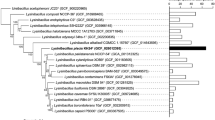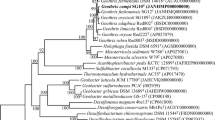Abstract
The strain NSC3T, a novel, facultative, chemolithotrophic, denitrifying, alkaliphilic, sulfide-oxidizing bacterium isolated from a hot spring in Yang-Ming Mountain, Taiwan, was Gram negative, rod shaped, and motile by single polar flagella and grew facultatively by adopting a denitrifying metabolism. The 16S rRNA sequence analysis revealed that strain NSC3T belongs to beta subclass of the Proteobacteria and most closely related to Azoarcus evansii KB740T (95.44 %), Azoarcus toluvorans Td-21T (95.21 %), Azoarcus tolulyticus Tol-4T (95.08 %), and Azoarcus toluclasticus MF63T (94.94 %). The phylogenetic analyses based on 16S rRNA gene sequences indicated that the strain NSC3T formed a distinct lineage in the Betaproteobacteria and that it exhibited the highest level of sequence similarity with species of the genera Azoarcus (95.28–93.13 %). The major fatty acids of the type strain were C16:0 (26.9 %), C16:1w7c (28.9 %), C18:0 (9.6 %), and C18:1w7c/w6c (29.9 %). The DNA G+C content of genomic DNA was 63.7 mol%. On the basis of the 16S rRNA sequence similarity, phenotypic and genotypic characteristics, and chemotaxonomic data, the strain NSC3T could be differentiated from other species of the genus Azoarcus. Therefore, strain NSC3T (equal to BCRC 80111T and DSM 24109T) is proposed as a novel species in genus Azoarcus, for which the name Azoarcus taiwanensis sp. nov. is proposed. The strain NSC3T is deposited in Bioresource Collection and Research Center, Taiwan, under the reference number BCRC 80111T, and German Collection of Microorganisms and Cell Cultures, Germany (DSMZ), with DSM 24109T.


Similar content being viewed by others
References
Anders HJ, Kaetzke A, Kampfer P, Ludwig W, Fuchs G (1995) Taxonomic position of aromatic-degrading denitrifying pseudomonad strains K 172 and KB 740 and their description as new members of the genera Thauera, as Thauera aromatica sp. nov., and Azoarcus, as Azoarcus evansii sp. nov., respectively, members of the beta subclass of the Proteobacteria. Int J Syst Bacteriol 45:327–333
APHA (1998) Standard methods for the examination of water and wastewater, 20th ed. American Public Health Association. Washington DC, USA
Chen C, Ren NQ, Wang AJ, Yu ZG, Lee DJ (2008a) Microbial community of granules in EGSB reactor for simultaneous biological removal of sulfate, nitrate, and COD. Appl Microbiol Biotechnol 79:1071–1077
Chen C, Ren NQ, Wang AJ, Yu ZG, Lee DJ (2008b) Simultaneous biological removal of sulfur, nitrogen and carbon using EGSB reactor. Appl Microbiol Biotechnol 78:1057–1063
Chen C, Wang AJ, Ren NQ, Kan HJ, Lee DJ (2008c) Biological breakdown of denitrifying sulfide removal process in high-rate expanded granular bed reactor. Appl Microbiol Biotechnol 81:765–770
Chun J, Lee JH, Jung Y, Kim M, Kim S, Kim BK, Lim YW (2007) EzTaxon: a web-based tool for the identification of prokaryotes based on 16S ribosomal RNA gene sequences. Int J Syst Evol Microbiol 57:2259–2261
Gupta AB (1997) Thiosphaera pantotropha: a sulphur bacterium capable of simultaneous heterotrophic nitrification and aerobic denitrification. Enzym Microb Technol 21:589–595
Kampfer P, Buczolits S, Albrecht A, Busse HJ, Stackebrandt E (2003) Towards a standardized format for the description of a novel species (of an established genus): Ochrobactrum gallinifaecis sp. nov. Int J Syst Evol Microbiol 53:893–896
Kelly DP, Chambers LA, Thudinger PA (1969) Cyanolysis and spectrophotometric estimation of trithionate in mixtures with thiosulfate and tetrathionate. Anal Chem 41:898–901
Kumar S, Tamura K, Nei M (2004) MEGA3: integrated software for molecular evolutionary genetics analysis and sequence alignment. Brief Bioinform 5:150–163
Lee DJ, Pan XL, Wang AJ, Ho KL (2013) Facultative autotrophic denitrifiers in denitrifying sulfide removal granules. Bioresour Technol 132:356–360
Manaia CM, Nunes OC, Nogales B (2003) Caenibacterium thermophilum gen. nov., sp. nov., isolated from a thermophilic aerobic digester of municipal sludge. Int J Syst Evol Microbiol 53:1375–1382
Moest RR (1975) Hydrogen sulfide determination by the methylene blue method. Anal Chem 47:1204–1205
Nemati M, Jenneman GE, Voordouw G (2001) Mechanistic study of microbial control of hydrogen sulfide production in oil reservoirs. Biotechnol Bioeng 74:424–434
Pfennig N, Lippert KD (1966) Uber Das Vitamin B12-Bedurfnis Phototropher Schwefelbakterien. Arch Microbiol 55:245–256
Reinhold-Hurek B, Hurek T, Gillis M, Hoste B, Vancanneyt M, Kersters K, De Ley J (1993) Azoarcus gen. nov., nitrogen-fixing proteobacteria associated with roots of Kallar grass (Leptochloa fusca (L.) Kunth), and description of two species, Azoarcus indigens sp. nov. and Azoarcus communis sp. nov. Int J Syst Bacteriol 43:574–584
Robertson LA, Kuenen JG (1983) Thiosphaera pantotropha gen. nov. sp. nov., a facultatively anaerobic, facultatively autotrophic sulphur bacterium. J Gen Microbiol 129:2847–2855
Smibert RM, Krieg NR (1994) Phenotypic characterization. In: Gerhardt P, Murray RGE, Wood WA, Krieg NR (eds) Methods for general and molecular bacteriology. American Society for Microbiology, Washington, DC, pp 607–655
Song B, Haggblom MM, Zhou JZ, Tiedje JM, Palleroni NJ (1999) Taxonomic characterization of denitrifying bacteria that degrade aromatic compounds and description of Azoarcus toluvorans sp. nov. and Azoarcus toluclasticus sp. nov. Int J Syst Bacteriol 49:1129–1140
Sorokin DY (2003) Oxidation of inorganic sulfur compounds by obligatively organotrophic bacteria. Microbiology 72:641–653
Sorokin DY, Lysenko AM, Mityushina LL (1996) Isolation and characterization of alkaliphilic chemoorganoheterotrophic bacteria oxidizing reduced inorganic sulfur compounds to tetrathionate. Microbiology 65:326–338
Sorokin DY, Teske A, Robertson LA, Kuenen JG (1999) Anaerobic oxidation of thiosulfate to tetrathionate by obligately heterotrophic bacteria, belonging to the Pseudomonas stutzeri group. FEMS Microbiol Ecol 30:113–123
Springer N, Ludwig W, Philipp B, Schink B (1998) Azoarcus anaerobius sp. nov., a resorcinol-degrading, strictly anaerobic, denitrifying bacterium. Int J Syst Bacteriol 48:953–956
Stackebrandt E, Goebel BM (1994) Taxonomic note: a place for DNA–DNA reassociation and 16s rRNA sequence analysis in the present species definition in bacteriology. Int J Syst Bacteriol 44:846–849
Tamura K, Dudley J, Nei M, Kumar S (2007) MEGA4: Molecular Evolutionary Genetics Analysis (MEGA) software version 4.0. Mol Biol Evol 24:1596–1599
Zecca L, Rosati M, Renella R, Galimberti M, Ambrosini A, Fariello RG (1998) Nitrite and nitrate levels in cerebrospinal fluid of normal subjects. J Neural Transm 105: 627–633
Zhou J, Fries MR, Chee-Sanford JC, Tiedje JM (1995) Phylogenetic analyses of a new group of denitrifiers capable of anaerobic growth on toluene and description of Azoarcus tolulyticus sp. nov. Int J Syst Bacteriol 45:500–506
Author information
Authors and Affiliations
Corresponding author
Electronic supplementary material
Below is the link to the electronic supplementary material.
ESM 1
(DOCX 222 kb)
Rights and permissions
About this article
Cite this article
Lee, DJ., Wong, BT. & Adav, S.S. Azoarcus taiwanensis sp. nov., a denitrifying species isolated from a hot spring. Appl Microbiol Biotechnol 98, 1301–1307 (2014). https://doi.org/10.1007/s00253-013-4976-9
Received:
Revised:
Accepted:
Published:
Issue Date:
DOI: https://doi.org/10.1007/s00253-013-4976-9




